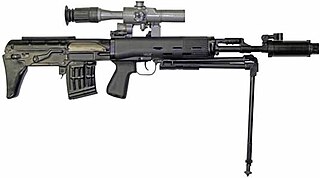
A bullpup firearm is one with its firing grip located in front of the breech of the weapon, instead of behind it. This creates a weapon with a shorter overall length for a given barrel length, and one that is often lighter, more compact, concealable and more maneuverable than a conventionally configured firearm. Where it is desirable for troops to be issued a more compact weapon, the use of a bullpup configuration allows for barrel length to be retained, thus preserving muzzle velocity, range and ballistic effectiveness.

The TKB-408Korobov was a bullpup assault rifle prototype by Soviet designer German A. Korobov presented in 1946. The TKB-408 was submitted to a set of official trials conducted in 1946 to select an assault rifle for the Red Army. The Soviet Army commission found it unsatisfactory, with the trials eventually selecting Mikhail Kalashnikov's AK-47.

The OTs-14-4 "Groza-4" is a Russian selective fire bullpup assault rifle chambered for the 9×39mm subsonic cartridge. It was developed in the 1990s at the TsKIB SOO in Tula, Russia.

Imperial Tula Arms Plant is a Russian weapons manufacturer founded by Tsar Peter I of Russia in 1712 in Tula, Tula Oblast as Tula Arsenal. Throughout its history, it has produced weapons for the Russian state. Its name was changed from Tula Arsenal to Tula Arms Plant during the Soviet era.

The Barrett M95 is a bolt-action rifle chambered in .50 BMG (12.7×99mm), and manufactured by Barrett Firearms Company. It has been adopted by a number of militaries around the world.
The TKB-517 is an assault rifle designed by German Aleksandrovich Korobov. This rifle was externally similar to the AK-47, but based on the lever-delayed blowback mechanism invented by John Pedersen and refined by Pál Király. It turned out to be more reliable, more accurate and controllable under full auto, and easier to produce and maintain. Like the AK series, it was also manufactured with folding stocks, longer, heavier barrels with bipods and even a belt-fed variant. Its rejection was because of a greater proficiency with the AK-47 among the Soviet military, though it is just as likely it was rejected due to relatively high extraction pressure, which is a common issue firearms using lever-delayed blowback actions.

Nikolay Mikhailovich Afanasyev, also known as Nicolai Michaelovich Afanasiev, was a Russian firearms designer.
The 5.6×39mm, also known in the U.S. as .220 Russian, is a cartridge developed in 1961 for deer hunting in the USSR. It fires a 5.6mm projectile from necked down 7.62×39mm brass. While it originally re-used 7.62x39 cases, once it became popular enough commercial ammunition started being manufactured, both in the USSR and in Finland. When it was introduced to the United States by SAKO it was stamped .220 Russian. Lapua later changed the designation to .220 Russian for the American market as well.

TKB-022PM No. 1, TKB-022PM No. 2 and TKB-022PM5 No. 1 were Soviet bullpup assault rifles, capable of fully automatic fire, chambered for the 7.62×39mm round and the .220 Russian round, developed by the small arms designer German A. Korobov in the 1960s.

An assault rifle is a selective fire rifle that uses an intermediate cartridge and a detachable magazine. Assault rifles were first put into mass production and accepted into widespread service during World War II. The first assault rifle to see major usage was the German StG 44, a development of the earlier Mkb 42. While immediately after World War II, NATO countries were equipped with battle rifles, the development of the M16 rifle during the Vietnam War prompted the adoption of assault rifles by the rest of NATO. By the end of the 20th century, assault rifles had become the standard weapon in most of the world's armies, replacing full-powered rifles and submachine guns in most roles. The two most successful modern assault rifles are the AK-47 and the M16 designs and their derivatives.

TKB-059 (ТКБ-059) was a Soviet three-barrel bullpup assault rifle, capable of fully automatic fire, chambered for the 7.62×39mm round and manufactured by Tula Arms Plant in 1966. It was based on the Device 3B, an earlier experimental assault rifle with three barrels. Both weapons were developed by the small arms designer Gennadij Korobov.

The TKB-0146 is a bullpup assault rifle prototype designed by Igor Yakovlevich Stechkin at the TsKIB SOO. The gun participated in the Russian Army's Project Abakan assault rifle trials.
The TKB-506 was a small handgun designed to look like a cigar cutter, developed by Igor Stechkin, allegedly on the orders of the KGB.

The ADS is a Russian assault rifle specially made for combat divers. It is of a bullpup layout and is chambered in the 5.45×39mm M74 round. The ADS can adapt a suppressor and optical sights.
The TKB-09 (ТКБ-09) was a Soviet delayed blowback assault rifle chambered in 5.45×39mm. It used a bolt attached to a spring in a tube above the barrel. The TKB-09 was intended to force the weight forward as means of increasing accuracy. TKB-010 was the variant chambered in 7.62×39mm.

The Bushmaster Arm Pistol was a 5.56×45mm NATO firearm, categorizeable as either a long pistol or compact carbine rifle, produced by the Gwinn Firearms Company, and later Bushmaster Firearms Inc. The firearm was a new design, having a tipping-block bolt system combined with a long stroke piston system similar to the AK-47 rifle.

The Central Design and Research Bureau of Sporting and Hunting Arms, abbreviated TsKIB SOO is a Russian small arms design bureau based in Tula, Russia. It was established in 1946, and it is currently managed as a branch of the KBP Instrument Design Bureau.

Igor Yakovlevich Stechkin was a Russian small arms designer.

The Malyuk, also known as Vulcan or Vulcan-M, is an assault rifle developed by the Ukrainian arms company Interproinvest (IPI).















